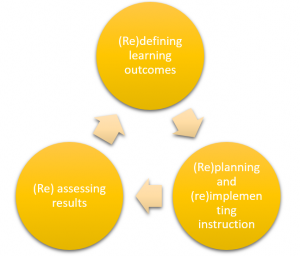
SEE ONE: HOW
In this unit, an introduction about how to plan and implement educational assessment is presented.
In this scope, the topics developed include principles for designing and implementing assessment and playful assessment elements.
CONTENTS
EXERCISES / TASKS
LEARNING OUTCOMES
SEE ONE – Pedagogy of online assessment (HOW)
Assessment in the teaching and learning processes.
Principles of designing and implementing assessment and online assessment.
Playful assessment elements.
Read texts.
Analyse videos and images.
Exercises
Align learning goals and assessment.
Identify assessment quality criteria.
Characterize assessment criteria.
Identify strategies to implement online and playful assessment.
Assessment in the teaching and learning processes
Assessment is a key activity in the teaching and learning processes.
It should be considered since the beginning and must be aligned with learning outcomes, contents and activities.
The learning and assessment cycle

Learning outcomes are what students should know or be able to do by the time a lesson is completed. Assessment determines whether the course's learning outcomes are met. It is used to determine if learning is happening, to what extent and if changes need to be made.
Assessment may focus on different types of learning outcomes: e.g. cognitive, affective, social, and shall take into account its specificity.
General principles to design assessment
To implement educational assessment there are some guidelines to consider.
ALIGN LEARNING GOALS AND ASSESSMENT
In order to align learning goals and assessment, an assessment map/matrix can be developed. It is a tool to match the students learning outcomes to assessment methods.
USE THE APPROPRIATE TEST ITEMS
Teacher-made tests can consist of true-false, matching, fill-in-the-blank, multiple choice, and essay items. Each type has its own advantages and disadvantages.
To reduce bias, the teacher should make their expectations for essay answers clear to students, write sample answers ahead of time, and use techniques to reduce expectancy effects.
In general, test items should…
- Be aligned with learning outcomes
- “Measure important aspects of the subject (concepts and conceptual relations)
- Accurately reflect the emphasis placed on important aspects of instruction
- Measure an appropriate level of student knowledge
- Vary in levels of difficulty” (Clay, 2001).
MAKING ASSESSMENT VALID, RELIABLE AND FAIR
There are three technical concepts that are used to describe the quality of assessment and evaluation information, namely validity, reliability, and fairness.
- Validity is a key quality referring to the degree that assessment and evaluation are measuring what is intended to.
- Reliability refers to the consistency for results obtained over time.
- Test fairness refers to the degree that it does not discriminate “against a particular group of students because of their race, ethnicity or gender (Arends, p.256).
Establishing criteria: how does the success look like
When aligning assessment with learning outcomes, it is also important to establish standards of performance, describing the criteria that will be used to judge whether the desired level of performance has been achieved.
Criteria should capture the multiple dimensions of student performance and identify a range of diverse performance measures.
Constructively aligned assessment criteria begin with a noun that complements the verb in the assessment tasks objective. For example, if the objective is for students to "explain how concepts in the subject interrelate" one of the criteria might be "Clarity of explanation". That is, the criterion describes the quality in the assessment task that will be judged during marking. Other commonly used quality words used in criteria include: Accuracy, Currency, Depth, Impact, Legibility, Originality, Succinctness, Relevance (UTS, https://www.uts.edu.au/research-and-teaching/learning-and-teaching/assessment/assessment-criteria)
Rubrics
Rubrics are scoring guides that state criterion and describe levels of quality. They are working tools for teachers and students and should be developed at the beginning of the learning process, proving students the criteria on which they will be assessed. The purpose of the rubric is not only to evaluate but also to help students increase their level of performance by outlining a vision of success” (Stein, 2006).
Rubrics can be holistic or analytic.
There are two main steps to develop a rubric :
- determine learning outcomes
- determine measurable criteria
Rubrics
Rubrics are scoring guides that state criterion and describe levels of quality. They are working tools for teachers and students and should be developed at the beginning of the learning process, proving students the criteria on which they will be assessed. The purpose of the rubric is not only to evaluate but also to help students increase their level of performance by outlining a vision of success” (Stein, 2006).
Rubrics can be holistic or analytic.
There are two main steps to develop a rubric :
- determine learning outcomes
- determine measurable criteria
More information about the principles to design assessment and align learning outcomes and assessment methods is presented in the infographic Blended and online taxonomy assessment design.

Assessment and online assessment: similarities & differences
Simon McIntyre and Karin Watson, UNSW Australia (The University of New South Wales) characterize online assessment strategies and explain how general assessment procedures are similar in face-to-face and online assessment
Acknowledgements: We thank Simon McIntyre and his team for allowing the use of their videos.
Bringing playful elements to assessment
The MIT Education Arcade, in collaboration with the Teaching Systems Lab, is exploring how to create and implement assessment that are playful and authentic.In this scope some principles are established, as:
- “ A well-designed assessment should be seen as a tool to help students learn and progress, rather than as a threat or ultimatum”.
- “(…) formative assessments that are woven throughout learning experiences rather than interrupting the flow of an activity.
- They should be authentic in that the interactions feel relevant and students know why they are using them”. https://tsl.mit.edu/playfulassessment/
Examples
Ways to design playful assessments for the learning experiences are being explored by teams of the projects.
MetaRubric
Know about your knowledge
Exercise See One How 1
Visualize the video Playful formative assessment and identify elements of playful pedagogy and formative assessment.
Exercise See One How 1
Exercise See One How 2
What is online assessment and how can it be implemented in a playful mode?
RECAP
Recap of central points covered in the ‘1-5 see one - how - sections’:
